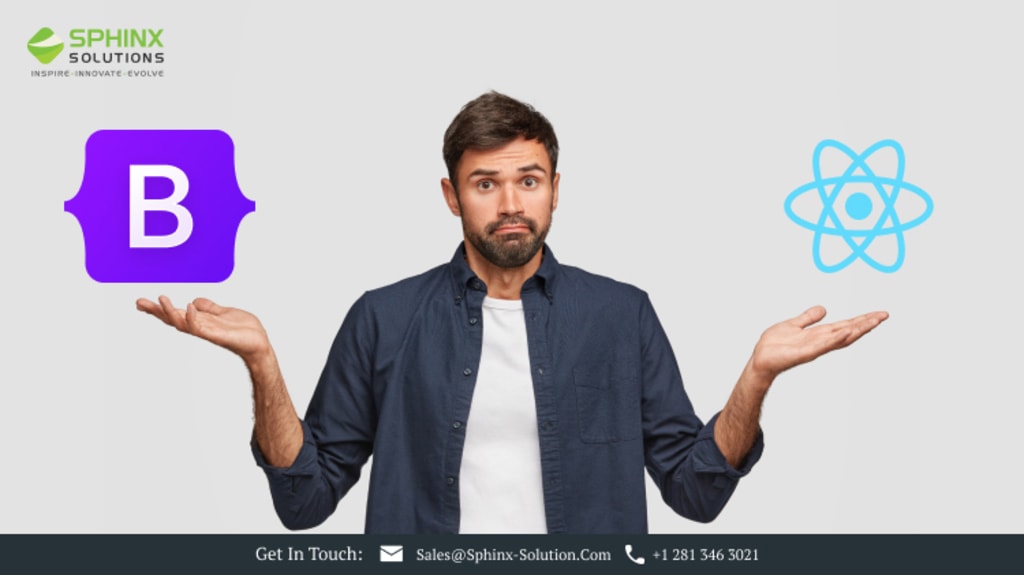Bootstrap Vs React: Which is The Best Front-End Framework?
Bootstrap and React are extensively used in web development to assist developers.

In the field of dynamic web and mobile app development, some technologies are invented, and some are modified or dissipated. Bootstrap and React are two popular technologies that have emerged as integral components of custom web development. Though Bootstrap is a front-end framework and React is a Javascript library, their distinct contributions make them the most preferred options for both professional and novice developers. Both technologies have different use cases and applications that assist developers to achieve desired outcomes efficiently. This blog will give you a complete guide to Bootstrap vs React & help you explore the Bootstrap React components. Let’s get started.
What is Bootstrap?
Launched in 2011, Bootstrap is one of the best open-source CSS frameworks which is extensively used in front-end web development. Bootstrap’s framework template is based on CSS and it has become more popular due to responsive design and multi-site compatibility.
Bootstrap framework is free to use and it also includes different HTML and CSS-based design templates for forms, tables, modals, image carousels, navigation, typography, and so on.
With the help of JavaScript plug-ins, Bootstrap also helps developers to create responsive websites. Some of the key benefits of using this framework include:
1. Rapid development: One of the biggest advantages of using Bootstrap is rapid development. Developers with knowledge of HTML and CSS can easily develop a code structure with the help of the Bootstrap framework.
Looking For The Best Web Development Services?
We provide comprehensive web development solutions that bring desired value to your customers.
2. Easy to use: Unlike other front-end frameworks designed for professionals, Bootstrap front end mostly targets novice developers. Therefore, with this platform, anyone can easily upgrade their coding skills.
3. UI components: The Bootstrap framework comes with several components helpful for expert developers. Moreover, this platform is designed to be compatible with multiple web browsers which minimizes the necessity for manual testing.
4. Grid System: Bootstrap’s grid system is a very practical and well-preferred feature for developers. Rowing, numbering, and column alignment are easy tasks that are responsive for every screen size.
5. Responsiveness: Responsiveness is one of the success keys to any website. Bootstrap is the best option that helps to create highly responsive websites. The grid system & UI components of this platform are designed to be responsive. This means the website will adjust its layout automatically based on the screen size.
What are the use cases of Bootstrap?
The Bootstrap framework is used for a diverse range of web development solutions. It can accelerate and streamline the overall process of developing a visually appealing and responsive website. Some of the major use cases of Bootstrap include:
• Microblogging applications
• Video streaming apps
• Social media apps
• Responsive web apps
• E-commerce websites
• Content-based website
• On-demand applications
• Geo-location applications
• Messaging service web app
• Payment applications
What is React.js?
Developed in 2013, React.js is a well-known Javascript library that is broadly used to create feature-rich web apps. The high flexibility of this open-source library allows developers to build reusable custom web app components.
In addition, it also helps in fast web page rendering that makes React.js more search engine friendly. Technically, React front end framework is a great option that makes complex and lightweight business application development easier. Key benefits of React.js include:
1. Component-based architecture: React has reusable UI components that help in managing complex user interfaces (UIs). These components can easily be reused, reused, nested, and composed to promote a maintainable and modular codebase.
2. Virtual DOM: React mainly uses the virtual DOM or virtual representation for computing minimal DOM operations while UI re-rendering. This reduces the cost of direct DOM manipulation and results in more effective performance.
3. Quick updates: The virtual DOM and reconciliation algorithm of React.js enable it to quickly update the important UI components parts when data starts changing. This improves overall performance & minimizes unwanted rendering.
4. Server-Side Rendering: SSR is one of the major benefits of the React.js library. It can also be used for server-side rendering that enhances SEO and the initial loading time of your web app by rendering UI components before delivering them to the clients.
5. Documentation & community: The official documentation of React.js is well-maintained as well as comprehensive. This offers clear examples and explanations for different concepts and multiple features.
What are the use cases of react.js?
As a highly versatile JavaScript library, React.js is used in different scenarios to develop interactive and dynamic user interfaces. Some of the major React.js use cases are:
• Web applications
• Video streaming platforms
• Software as a Service (SaaS) tools
• Desktop Applications
• Progressive Web Apps (PWAs)
• Media sites
• Mobile applications (React Native)
• JAMstack sites
Bootstrap vs React: key comparisons
While comparing Bootstrap and React, there are many things to consider. Here is a complete table that describes the major comparisons between them.
Aspects Bootstrap React
Definition Open-source front-end framework Open-source JavaScript library
Use Case Used to build responsive websites Used to build dynamic UIs (user interfaces)
Architecture CSS-centric architecture Component-based architecture
Offerings Offers pre-designed styles Mainly works on UI rendering
Styling Pre-designed styles & components Customizable components & styles
Responsive Responsive grid systems Offers responsive design support
DOM Limited (for layout & styling only) Virtual DOM manipulation
Speed Rapid development speed with built-in components Fast development & Initial learning curve
Performance Best for user interface layout Virtual DOM increases rendering efficiency
Mobile development Very limited support React Native used for mobile application development
Customization Limited customization Highly customizable & extensible
Community Active & extensive community Broad community & range of libraries
Library integration Integrated with different libraries Smooth integration with different tools
Complexity Ideal for UI-heavy applications Best for complex and dynamic applications
What are Bootstrap-React components?
Bootstrap-React components technically refer to adding the UI components of Bootstrap into the React applications. We know that as one of the most popular open-source frameworks, Bootstrap offers a set of built-in UI elements like forms, buttons, modals, navigation bars, etc. On the other hand, as the JavaScript library, React is used to create UIs with the help of component-based architecture.
After integrating Bootstrap into React, you can easily use premade Bootstrap UI components with the React project. This helps developers take advantage of Bootstrap's functionality and styling while leveraging the rendering capabilities and component reusability of React.js. Professional developers widely use different third-party packages or libraries to streamline the Bootstrap component integration process.
How to use Bootstrap in React?
Using Bootstrap in React is a very straightforward process. As a renowned CSS framework, it offers a range of pre-designed styles and UI components that can easily be integrated into React applications. Here is a quick step on how to integrate Bootstrap into the React-based project:
1. Develop a react project: Create and set up a react-based project with a preferred method first.
2. Install Bootstrap: Next, you need to use yarn or npm for installing Bootstrap in the project.
3. Import Bootstrap styles: Step 3 refers to importing Bootstrap’s CSS styles to ensure that styling will be properly applied to the components.
4. Use components: Now use pre-designed Bootstrap components in your React project. For example, you may add navigation bars, buttons, forms, and modals to improve the overall user interface (UI) of your app.
5. Customize styles: Though this step is optional, you may customize the default Bootstrap styles that match the design & branding of your projects. In addition, it allows you to modify typography, colors, spacing, and other elements using CSS or Bootstrap's classes.
6. Ensure responsiveness: Based on the screen sizes, the grid system of the Bootstrap framework will adjust the layout of UI components automatically. This will ensure that the final product will look and function properly on different devices.
7. Integrate React components: You can develop your React components & easily add them to Bootstrap elements while utilizing Bootstrap’s UI components. This helps you create a combination of built-in Bootstrap components and custom components.
8. Stay updated & informed: Last but not least, always focus on the latest updates & changes to both Bootstrap and React. It will help you understand the new features, further improvements, as well as bug fixes.
Want to Hire Web Developers?
Take your business to new heights with our industry-leading web development services.
Final words
Bootstrap and React both are intuitive technologies that take the front-end development process to the next level. They’re close competitors when it comes to customizing and designing the best user interfaces. While Bootstrap is an open-source template-based framework that offers pre-made templates to create stunning applications, as the component-based framework, React.js helps developers create more interactive and dynamic UIs. Considering the facilities and unique features offered by Bootstrap and React, deciding to choose the right one highly depends on business opportunities and project requirements.





Comments (1)
I love the comparison great job! Being